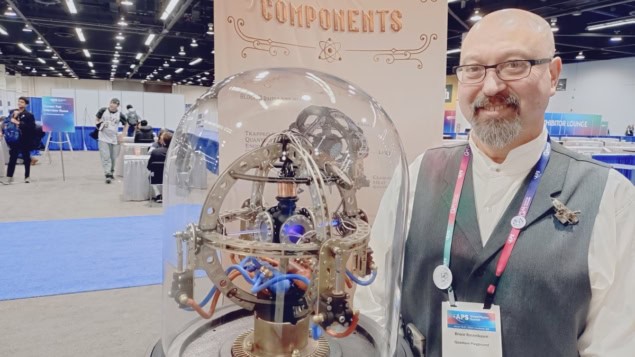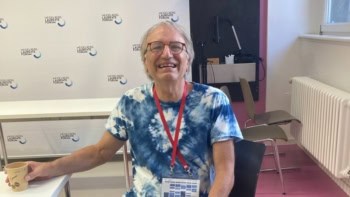
From the Global Physics Summit in Anaheim, California
Some of the most fascinating people that you meet at American Physical Society meetings are not actually physicists, and Bruce Rosenbaum is no exception. Based in Massachusetts, Rosenbaum is a maker of beautiful steampunk objects and he is in Anaheim with a quantum-related creation (see figure).
At first glance Rosenbaum’s sculpture of a “quantum engine” fits in nicely at a conference exhibition that features gleaming vacuum chambers and other such things. However, this lovely artistic object is meant to be admired, rather than being a functioning machine.
At the centre of the object is a small vacuum chamber that could hold a single trapped ion – which could be operated as a quantum engine. Lasers are pointed at the ions through the chamber windows and the chamber is surrounded by a spherical structure that represents both the Bloch sphere of quantum physics and an armillary sphere. The latter being used to demonstrate the motions of celestial objects in the days before computers. But as someone who, many years ago, did some electron spectroscopy, the rings are more reminiscent of Helmholtz coils that would screen the ion from Earth’s magnetic field.
I should make it clear that the neither the vacuum chamber, nor the lasers are real — and there is no trapped ion. However, a real quantum engine based on a trapped ion has been created in a real physics lab. So, in principle, the sculpture could be made into a functional device by using “real components”.
Past and future connections
In my mind, the object symbolizes the connection between the state-of-the-art today (the trapped-ion qubit) and the many technologies that have come before (armillary sphere).
While Rosenbaum does not have a background in physics, I think he has a kinship with the thousands of experimental physicists who have built devices that bear a striking resemblance to this object. But some physicists were involved in the development of this beautiful object. They include Nicole Yunger Halpern of the University of Maryland. Yunger Halpern is a theorist who uses the ideas of quantum information to study thermodynamics. She describes the field as “quantum steampunk” because like the artistic genre of steampunk, it combines 19th century concepts (thermodynamics) with the 21st century concepts of quantum science and technology.
I had a lovely chat with Rosenbaum and he had some very interesting things to say about the intersection of creativity and technology – things that are highly relevant to physicists. I hope to have him and perhaps one of his physicist colleagues on a future episode of the Physics World Weekly podcast.



